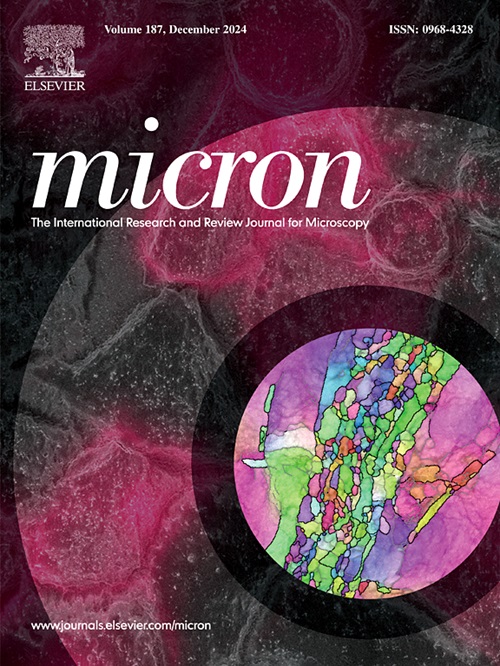A statistical approach for interplanar spacing metrology at a relative uncertainty below 10−4 using scanning transmission electron microscopy
IF 2.2
3区 工程技术
Q1 MICROSCOPY
引用次数: 0
Abstract
Atomic-scale metrology in scanning transmission electron microscopy (STEM) allows to measure distances between individual atomic columns in crystals and is therefore an important aspect of their structural characterization. Furthermore, it allows to locally resolve strain in crystals and to calibrate precisely the pixel size in STEM. We present a method dedicated to the evaluation of interplanar spacing (d-spacing) based on an algorithm including curve fitting of processed high-angle annular dark-field STEM (HAADF STEM) signals. By examining simulated data of perovskite cubic SrTiO3, we confirm that our proposed method is unbiased, and the precision is better than the significant digit of the input value. Then, we study experimental data to learn how electron dose, sampling resolution, and statistical sampling affect the mean and precision values of d110. For single d-spacing measurements using a probe corrected STEM, we find that uncertainty ranges between 1 and 3 pm. Here, we measure numerous d-spacings in an automated and statistical approach, resulting in relative uncertainties in mean values ≤ 10−4. Thus, we propose to calibrate TEMs using this method as it enables measuring lattice parameters at uncertainties comparable to reports of x-ray diffraction measurements, but with a significantly lower sample volume, in this case ∼ 10−3 µm3.
用扫描透射电子显微镜测量相对不确定度小于10-4的面间距的统计方法。
扫描透射电子显微镜(STEM)中的原子尺度计量允许测量晶体中单个原子柱之间的距离,因此是其结构表征的重要方面。此外,它允许局部解析晶体中的应变,并精确校准STEM中的像素大小。提出了一种基于曲线拟合算法的高角度环形暗场STEM (HAADF STEM)信号的平面间距(d-spacing)评估方法。通过对钙钛矿立方SrTiO3模拟数据的检验,我们证实了所提出的方法是无偏的,并且精度优于输入值的有效位数。然后研究实验数据,了解电子剂量、采样分辨率和统计采样对d110的平均值和精度值的影响。对于使用探针校正STEM的单d间距测量,我们发现不确定度范围在1到3 pm之间。在这里,我们用自动化和统计方法测量了许多d间隔,导致平均值的相对不确定性≤ 10-4。因此,我们建议使用这种方法校准tem,因为它能够以与x射线衍射测量报告相当的不确定度测量晶格参数,但样品体积显着降低,在这种情况下为10-3µm3。
本文章由计算机程序翻译,如有差异,请以英文原文为准。
求助全文
约1分钟内获得全文
求助全文
来源期刊

Micron
工程技术-显微镜技术
CiteScore
4.30
自引率
4.20%
发文量
100
审稿时长
31 days
期刊介绍:
Micron is an interdisciplinary forum for all work that involves new applications of microscopy or where advanced microscopy plays a central role. The journal will publish on the design, methods, application, practice or theory of microscopy and microanalysis, including reports on optical, electron-beam, X-ray microtomography, and scanning-probe systems. It also aims at the regular publication of review papers, short communications, as well as thematic issues on contemporary developments in microscopy and microanalysis. The journal embraces original research in which microscopy has contributed significantly to knowledge in biology, life science, nanoscience and nanotechnology, materials science and engineering.
 求助内容:
求助内容: 应助结果提醒方式:
应助结果提醒方式:


